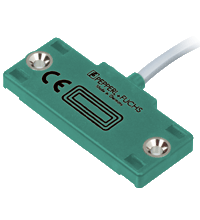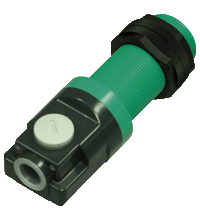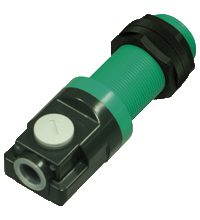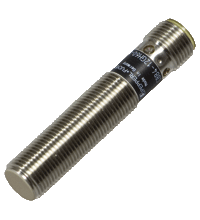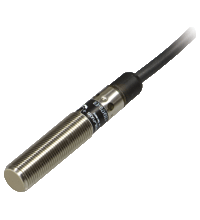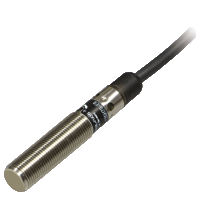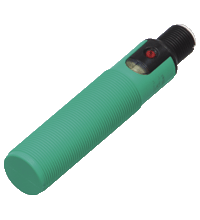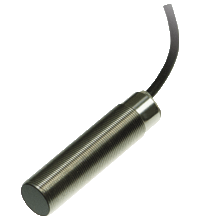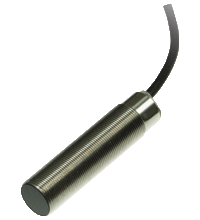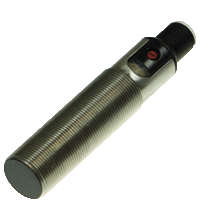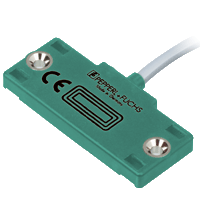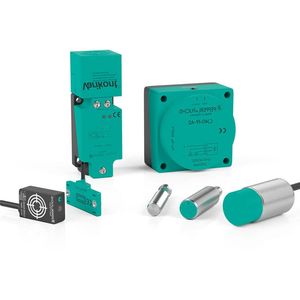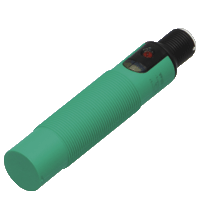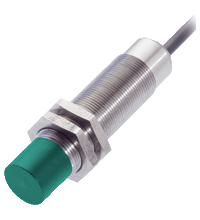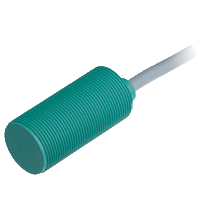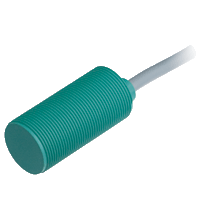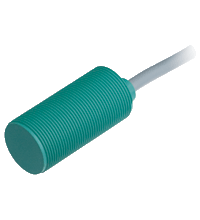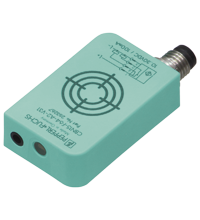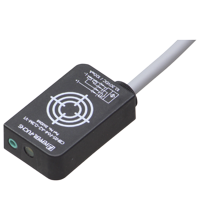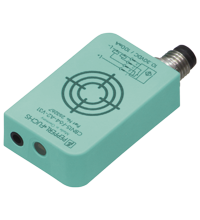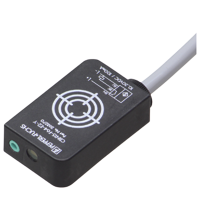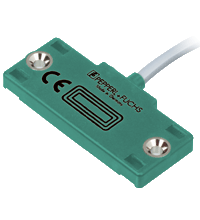Pepperl+Fuchs Proximity Capacitive Sensors
- 5 mm non-flush
- 3-wire DC
- Flat housing
- Mounting slots for cable ties
- Thru-holes for screw mounting
- 10 mm flush
- 15 mm non-flush
- The switching distance can be set over a wide range with the potentiometer
- 10 mm flush
- 15 mm non-flush
- The switching distance can be set over a wide range with the potentiometer
- NO/NC programmable
- 4 mm flush
- Operating distance adjustable via potentiometer
- Suitable for foodstuff conditions
- Resistant against aggressive media
- 4 mm flush
- Operating distance adjustable via potentiometer
- Suitable for foodstuff conditions
- Resistant against aggressive media
- 4 mm flush
- Operating distance adjustable via potentiometer
- Suitable for foodstuff conditions
- Resistant against aggressive media
- 8 mm flush
- The switching distance can be set over a wide range with the potentiometer
- 8 mm flush
- The switching distance can be set over a wide range with the potentiometer
- 8 mm flush
- The switching distance can be set over a wide range with the potentiometer
- 8 mm flush
- The switching distance can be set over a wide range with the potentiometer
- 10 mm non-flush
- 3-wire DC
- Flat housing
- Mounting slots for cable ties
- 15 mm non-flush
- The switching distance can be set over a wide range with the potentiometer
- 15 mm non-flush
- The switching distance can be set over a wide range with the potentiometer
- 15 mm non-flush
- The switching distance can be set over a wide range with the potentiometer
- 15 mm non-flush
- Operating distance adjustable via potentiometer
- High EMC resistance
- Complementary outputs
- 15 mm non-flush
- Operating distance adjustable via potentiometer
- High EMC resistance
- 15 mm non-flush
- Operating distance adjustable via potentiometer
- High EMC resistance
- 15 mm non-flush
- Flat housing
- Switching distance adjustable between 2 mm ... 15 mm
- 15 mm non-flush
- Flat housing
- Switching distance adjustable between 2 mm ... 15 mm
- 15 mm non-flush
- Flat housing
- Switching distance adjustable between 2 mm ... 15 mm
- 15 mm non-flush
- Flat housing
- Switching distance adjustable between 2 mm ... 15 mm
- 12 mm non-flush
- Flat housing
- 3-wire DC
- 12 mm non-flush
- Flat housing
- 3-wire DC
- 2 mm non-flush
- 3-wire DC
- Flat housing
- Mounting slots for cable ties
- Thru-holes for screw mounting
Pepperl+Fuchs was founded in 1945 and it is one of the biggest capacitive proximity sensors manufacturers in the world. Capacitive proximity switches are also non-contact sensors and react almost identically when conductive and non-conductive materials in solid, powder, or liquid states are to be measured. They work through non-metallic materials such as plastic or glass for filling level control and through various materials when counting objects. In this article, we will take a closer look at Pepperl+Fuchs proximity capacitive sensors.
Working Principle of Proximity Capacitive Sensors
Pepperl+Fuchs capacitive sensors are devices that perform object detection using electrical properties, and capacitance. They are widely used to detect and measure objects/liquids with a higher dielectric constant than air. This includes anything that is conductive or non-conductive.
Capacitive proximity sensors find many applications in industrial automation systems, from location determination to non-invasive analysis of the composition of objects.
Capacitive sensors have a robust construction and their main element is a capacitor, which can be made in a flat or cylindrical form. When the movable plate of the capacitor begins to move, increasing the distance to the fixed plate, the dielectric is deformed, and its position changes, leading to a change in the permittivity and many more parameters.
Features and Benefits of Pepperl+Fuchs Proximity Capacitive Sensors
The range of proximity sensors is limited. A significant change in the measured capacitance and inductance is observed near the sensitive element of the sensor. The sensor begins to "feel" the object only at fairly close distances, comparable to the size of the sensor itself. This zone of sensitivity is called the active zone. In the case of inductive sensors, it determines the region of the highest density of magnetic field lines. After an object enters the active zone, the sensor does not switch immediately, but when a certain threshold value is reached, which is set by an internal trigger with hysteresis. Hysteresis is necessary to avoid false positives. In this case, the switching on and off of the sensor occurs at different levels of oscillations.
All of the listed characteristics are not hard-coded. Their value is influenced by a number of factors: the material and size of the object, temperature drift, and technological parameters of the sensor itself. For this reason, all specifications given are measured using a specific object at normal temperature (typically 20 or 25°C).
Influence of the material and dimensions of the detection object on the parameters of inductive sensors. An approaching metal object acts as a core for the sensing coil. Obviously, the material and shape of the core have a significant impact on the value of the inductance.
For this reason, all ratings refer to a specific object, which is always indicated in the documentation for the sensor. Usually, it is an iron square plate with given dimensions.
It is important to understand that when setting up and installing the sensor, one should take into account the possibility of getting wet or oiling the object of observation. For example, even the thinnest water film will lead to a significant change in capacitance. Any user of a laptop with a touchpad can verify this. If the touchpad gets wet, the laptop will lose control until the sensor surface is completely dry. The same picture is observed in the case of industrial capacitive sensors.
Another feature to keep in mind when using non-contact sensors is the possibility of mutual influence of adjacent sensors. When mounting the sensors, it is not allowed to place them too close at distances smaller than those indicated in the documentation. This applies to both counter and parallel installations.
The main advantages of capacitive proximity sensors are:
- detection of all materials (eg plastics, wood, paper);
- measurement of liquids through plastic or glass pipes;
- measurement of aggressive chemicals;
- adjustable compensation of the working distance to the object.
Applications of Pepperl+Fuchs Proximity Capacitive Sensors
And now let's find out in which areas of application you can most often find capacitive proximity sensors products.
- Level detection.
- Material presence sensing.
- Fill level control.
- conveyor systems.
- Packaging industry.
- Liquid detection in pipes.
- Level control in silos.
- Proximity detection in CNC machines.
- Vending machines.
- Paper and printing industry.
- Automation and robotics.
- Machine safety systems.
- Hygiene-critical environments.
Installation and Maintenance of Proximity Capacitive Sensors
And now we will look at tips for installing and maintaining capacitive proximity sensors.
- Select the appropriate capacitive proximity sensor based on your application requirements, such as target material, response range, and environmental conditions.
- Install the sensor in a place where it can effectively detect the target. Make sure the target is within the specified sensitivity range of the sensor.
- Capacitive sensors can be affected by nearby metal objects. Keep the sensor away from large metal surfaces or other sources of interference that may affect its performance.
- Use the correct mounting hardware to mount the sensor securely. Make sure it is properly aligned and securely fastened to prevent accidental movement.
- Properly ground the sensor to minimize electrical noise and interference.
- Follow the wiring diagram in the sensor datasheet or user manual to connect the sensor to the control system. Make sure you are using the correct polarity and voltage.
- After installation, perform a functional test to ensure the sensor accurately detects the target. Check for false positives or missed detections.
- Perform routine inspections for physical damage, contamination, or deposits on the sensor and surrounding areas.
- Regularly clean the sensitive surface of the sensor with a soft, non-abrasive cloth or cleaner recommended by the manufacturer.
- Periodically check the sensor's sensitivity range to ensure it is still working within the specified distance. Recalibrate or relocate the sensor if necessary.
- Check wiring connections between the sensor and control system. Tighten any loose connections and make sure the cable is intact.
- Update firmware or settings, follow the manufacturer's instructions to update the sensor's firmware, or change settings to optimize performance for your application.
- During maintenance, disconnect the sensor from the power supply and take appropriate safety measures to avoid accidents or injury.
